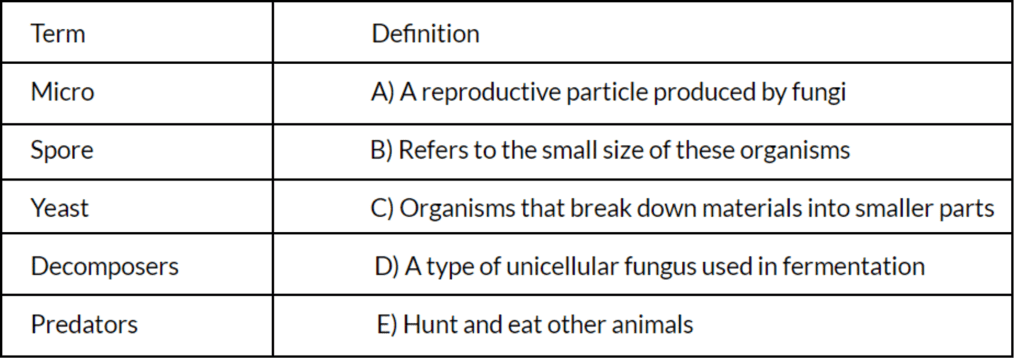Worksheet: Microorganisms | Year 7 Biology (Cambridge) - Class 7 PDF Download
| Table of contents |

|
| Multiple Choice Questions (MCQs) |

|
| Fill in the Blanks |

|
| Match the Column |

|
| True/False |

|
Multiple Choice Questions (MCQs)
Q1. What is a common trait of all microorganisms?
A) They are visible to the naked eye.
B) They consist of multiple cells.
C) They are too small to be seen without a microscope.
D) They can survive without water.
Answer: C) They are too small to be seen without a microscope.
Explanation: Microorganisms, also known as microbes, include bacteria, viruses, and fungi, and are generally too small to be seen without the aid of a microscope.
Q2.Which of the following is NOT a type of microorganism?
A) Bacteria
B) Virus
C) Algae
D) Yeast
Answer: C) Algae
Explanation: Algae are typically considered a separate group of organisms, distinct from microorganisms such as bacteria, viruses, and fungi like yeast.
Q3. Which microorganism is primarily responsible for the fermentation of yoghurt?
A) Yeast
B) Lactic acid bacteria
C) Mould
D) Virus
Answer: B) Lactic acid bacteria
Explanation: Yoghurt is made by the fermentation of milk by lactic acid bacteria, which convert lactose into lactic acid.
Q4. Where was yoghurt believed to have originated approximately 7000 years ago?
A) China
B) North America
C) Iran, Iraq, and Syria
D) Australia
Answer: C) Iran, Iraq, and Syria
Explanation: Historical evidence suggests that yoghurt originated in regions now known as Iran, Iraq, and Syria around 7000 years ago.
Q5. What is the primary function of microorganisms in yoghurt production?
A) To add flavor
B) To preserve milk
C) To color the yoghurt
D) To increase the fat content
Answer: B) To preserve milk
Explanation: In yoghurt production, microorganisms ferment milk, producing lactic acid that helps preserve the milk by preventing spoilage.
Fill in the Blanks
Q1. Microorganisms are usually too small to be seen without a __________.
Answer: microscope
Explanation: A microscope is necessary to see microorganisms due to their extremely small size.
Q2. The process of making yoghurt involves the fermentation of milk by __________.
Answer: bacteria
Explanation: Yoghurt is made by fermenting milk specifically with lactic acid bacteria.
Q3. Fungi absorb nutrients from organic materials because they do not __________.
Answer: photosynthesize
Explanation: Unlike plants, fungi do not have the capability to photosynthesize; they absorb nutrients directly from their environment.
Q4. Bacteria are __________ organisms, which means they consist of a single cell.
Answer: unicellular
Explanation: Bacteria are made up of only one cell, making them unicellular organisms.
Q5. Viruses are not considered living cells but are tiny particles that __________.
Answer: infect living cells
Explanation: Viruses must enter and hijack the cellular machinery of living cells to replicate.
Match the Column

Answers: Micro - B, Spore - A, Yeast - D, Decomposers - C, Predators - E
Explanation:
- Microorganisms: Refers to extremely small living things, hence matched with option B.
- Spore: A reproductive particle produced by fungi, matching with option A.
- Yeast: A type of unicellular fungus used in fermentation, corresponding with option C.
- Decomposers: Organisms that break down materials into smaller parts, fitting with option D.
True/False
Q1. All fungi are unicellular.
Ans: (False)
Explanation: Fungi can be either unicellular, like yeasts, or multicellular, like mushrooms.
Q2. Louis Pasteur proved that microorganisms are responsible for food spoilage.
Ans: (True)
Explanation: Through his experiments, Pasteur demonstrated that microorganisms in the air spoil food.
Q3. Viruses can photosynthesize.
Ans: (False)
Explanation: Viruses are not capable of photosynthesis; they require a host cell to reproduce.
Q4. Bacteria are involved in both beneficial and pathogenic processes.
Ans: (True)
Explanation: Bacteria play roles in beneficial processes like digestion and harmful ones like causing diseases.
Q5. All energy in an ecosystem is transferred from producers to consumers without any loss.
Ans: (False)
Explanation: Not all energy consumed at one trophic level is transferred to the next; some is lost as heat during metabolic processes.
|
7 videos|17 docs|4 tests
|
FAQs on Worksheet: Microorganisms - Year 7 Biology (Cambridge) - Class 7
| 1. What are microorganisms? |  |
| 2. How do microorganisms affect our daily lives? |  |
| 3. Can all microorganisms harm humans? |  |
| 4. How can we prevent the spread of harmful microorganisms? |  |
| 5. Are antibiotics effective against all types of microorganisms? |  |




















